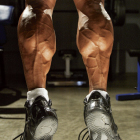 Q: Do some muscles respond better to longer tension times? For example, I’ve heard that calves do best with high reps, but what about hamstrings? And do everyone’s muscles respond the same way?
Q: Do some muscles respond better to longer tension times? For example, I’ve heard that calves do best with high reps, but what about hamstrings? And do everyone’s muscles respond the same way?
A: A muscle that has a high percentage of slow-twitch fibers responds best to higher reps. Let’s look at how this concept applies to training the two groups you mentioned, calves and hamstrings.
The calf consists primarily of two muscles, the two-head gastrocnemius and the muscle that is located under it, the soleus. The gastrocnemius contains predominantly fast-twitch fibers and responds best to lower reps. In contrast, the soleus has predominantly slow-twitch fibers and responds best to reps in the 15-to-25 range. That provides sufficient time under tension for the fibers to hypertrophy.
Now let’s look at the hamstrings.
I’ve observed that sprinters and Olympic weightlifters often have much better hamstring development than bodybuilders have. It’s because the hamstrings are composed of primarily fast-twitch fibers, and to access them you must train them at a high level of intensity. If a bodybuilder is making exceptional progress on hamstrings while using more than eight reps, I would attribute that growth more to pharmacological reasons than to optimal workout design.
One practical way to determine muscle fiber type—and I must credit Nautilus creator Arthur Jones for coming up with it—is by examining how many times you can lift a submaximal weight. If two trainees have a one-rep max of 100 pounds on the barbell curl, the person who can curl 80 pounds only five times has more fast-twitch fibers than the one who can curl the same weight 10 times.
Compared to the usual method of determining fiber type, which involves taking painful muscle biopsies, Jones’ test is extremely convenient for untrained people. Even so, you can skew this relationship by making the body more neurologically efficient (with relative strength methods) or less neurologically efficient (with aerobic work).
Editor’s note: Charles Poliquin is recognized as one of the world’s most suc-cessful strength coaches, having coached Olympic med-alists in 12 different sports, including the U.S. women’s track-and-field team for the 2000 Olympics. He’s spent years researching European journals (he’s fluent in English, French and German) and speaking with other coaches and scientists in his quest to optimize training methods. For more on his books, seminars and methods, visit www.StrengthSensei.com. Also, see his ad in this issue. IM




















You must be logged in to post a comment Login